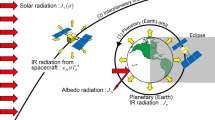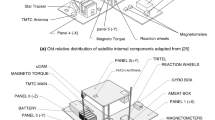Abstract
The article treats the descent of a stabilized spherical capsule to the Earth’s surface along the trajectory from near-lunar and low-Earth orbits. Approximate dependences approximating the known results of numerical and experimental studies are used to analyze the thermal protection environment of the capsule. The use of a material with a high degree of anisotropy of thermal conductivity in the composition of a heat-protective coating is considered. The results indicate that the capsule descent can be performed with no damage to its heat shielding.








Similar content being viewed by others
REFERENCES
Allen, H.J. and Eggers, A.J., Jr., A study of the motion and aerodynamic heating of ballistic missiles entering the Earth’s atmosphere at high supersonic speeds, NACA Technical Report 1381, Washington, DC: Natl. Aeronaut. Space Admin., 1958.
Chapman, G.T., Theoretical laminar convective heat transfer and boundary layer characteristics on cones at speeds to 24 km/s, NASA Technical Note D-2463, Washington, DC: Natl. Aeronaut. Space Admin., 1964.
Efanov, V.V., Martynov, M.B., and Karchaev, Kh.Zh., Aerial vehicles developed at Lavochkin Research and Production Association (On the 80th anniversary of the Lavochkin Association), Sol. Syst. Res., 2018, vol. 52, no. 7, pp. 557–569.
Finchenko, V.S., Kotlyarov, E.Yu., and Ivankov, A.A., Sistemy obespecheniya teplovykh rezhimov avtomaticheskikh mezhplanetnykh stantsii (Systems for Providing Thermal Regimes for Automatic Interplanetary Stations), Efanov, V.V. and Finchenko, V.S., Eds., Khimki: NPO im. S.A. Lavochkina, 2018.
Finchenko, V.S., Ivankov, A.V., Golomazov, M.M., and Shmatov, S.I., On the use of inflatable decelerators in the design of spacecraft intended for the study of Venus, Sol. Syst. Res., 2020, vol. 54, no. 7, pp. 595–602.
Galanin, M.P. and Savenkov, E.B., Metody chislennogo analiza matematicheskikh modelei (Methods for Numerical Analysis of Mathematical Models), Moscow: Mosk. Gos. Tekh. Univ. im. N.E. Baumana, 2018.
Golomazov, M.M. and Ivankov, A.A., Software package for the development of thermal protection systems for spacecraft descent into the atmospheres of planets, Sol. Syst. Res., 2018, vol. 52, no. 7, pp. 578–589.
Gordienko, E.S., Khudorozhkov, P.A., Simonov, A.V., Optimization of the return trajectories from the moon for delivering soil to a specified region on the Earth’s surface, Sol. Syst. Res., 2020, vol. 54, no. 7, pp. 654–661.
Gorskii, V.V. and Pugach, M.A., Comparison of calculated and experimental data on laminar-turbulent heat transfer on the hemisphere surface streamlined by a supersonic air flow, High Temp., 2015, vol. 53, no. 2, pp. 223–227.
GOST (State Standard) 4401-81: Standard Atmosphere. Parameters, 2004.
GOST (State Standard) R 25645.166-2004: Earth’s Upper Atmosphere. Density Model for Ballistic Support of Flights of Artificial Earth Satellites, 2004.
Johnson, J.E., Starkey, R.P., and Lewis, M.J., Aerothermodynamic optimization of reentry heat shield shapes for a crew exploration vehicle, J. Spacecr. Rockets, 2007, vol. 44, no. 4, pp. 849–859.
Johnston, C.O., Hollis, B.R., and Sutton, K., Nonequilibrium stagnation-line radiative heating for Fire-II, J. Spacecr. Rockets, 2008, vol. 45, pp. 1185–1195.
Khartov, V.V., Zelenyi, L.M., Dolgopolov, V.P., Efanov, V.V., et al., New Russian lunar unmanned space complexes, Sol. Syst. Res., 2011, vol. 45, no. 7, pp. 690–696.
Konvektivnyi teploobmen letatel’nykh apparatov (Convective Heat Transfer of Aerial Vehicles), Zemlyanskii, B.A., Ed., Moscow: Fizmatlit, 2014.
Kosenkova, A.V., Sedykh, O.Yu., Simonov, A.V., and Minenko, V.E., Study of accessible landing regions on the surface of Venus for spacecraft of various types, Vestn. NPO im. S.A. Lavochkina, 2021, no. 1, pp. 12–20.
Leonov, V.V., Grishko, D.A., Airapetyan, M.A., Shvyrkina, O.S., et al., Thermal analysis of trajectories of return from the Moon using several entries into the atmosphere for ballistic capsule and gliding descent vehicles, Cosmic Res., 2021a, vol. 59, no. 3, pp. 162–174. https://doi.org/10.1134/S0010952521030060
Leonov, V.V., Zarubin, V.S., Jr., and Airapetyan, M.A., Analysis of the effectiveness of anisotropic heat-protective material in the implementation of trajectories with multiple re-entries into the atmosphere, Izv. Vyssh. Uchebn. Zaved., Mashinostr., 2021b, no. 2, pp. 56–68. https://doi.org/10.18698/0536-1044-2021-2-56-68
Martin, J., Atmospheric Reentry: An Introduction to Its Science and Engineering, Englewood Cliffs, NJ: Prentice-Hall, 1966.
Nikitin, P.V., Teplovaya zashchita (Heat Protection), Moscow: Izd. Mosk. Aviats. Inst., 2006.
Olynick, D.R., Henline, W.D., Hartung, L.C., and Candler, G.V., Comparison of coupled radiative Navier–Stokes flow solutions with the Project Fire II flight data, 6th Joint Thermophysics and Heat Transfer Conf., Colorado Springs, CO, 1994, paper AIAA 94-1955.
Osnovy teploperedachi v aviatsionnoi i raketnokosmicheskoi tekhnike (Fundamentals of Heat Transfer in Aviation and Rocket and Space Technology), Avduevskii, V.S. and Koshkin, V.K., Eds., Moscow: Mashinostroenie, 1992.
Reviznikov, D.L. and Sukharev, T.Yu., Hypersonic flow-around of blunted bodies in conditions of earth and mars atmosphere. Comparative analysis of mathematical models, Tepl. Protsessy Tekh., 2018, vol. 10, nos. 1–2, pp. 5–15.
Shevelev, Yu.D. and Syzranova, N.G., The influence of chemical reactions on heat transfer in the boundary layer, Fiz.-Khim. Kinet. Gazov. Din., 2010, vol. 10, no. 2, pp. 91–126.
Siegel, R. and Howell, J.R., Thermal radiation heat transfer, New York: Taylor and Francis, 2002.
Sosedov, V.P., Svoistva konstruktsionnykh materialov na osnove ugleroda: spravochnik (Properties of Carbon-Based Structural Materials: A Handbook), Moscow: Metallurgiya, 1975.
Surzhikov, S.T. and Shuvalov, M.P., Analysis of radiative-convective heating of four types of descent spacecraft, Fiz.-Khim. Kinet. Gazov. Din., 2014, vol. 15, no. 4, pp. 1–18.
Sutton, K. and Graves, R.A., A general stagnation point convective heating equation for arbitrary gas mixtures, NASA Technical Report R-376, Washington, DC: Natl. Aeronaut. Space Admin., 1971.
Tauber, M.E., Some simple scaling relations for heating of ballistic entry bodies, J. Spacecr. Rockets, 1970, vol. 7, no. 7, pp. 885–886.
Teoriya teplomassoobmena (Theory of Heat and Mass Transfer), Leont’ev, A.I., Ed., Moscow: Izd. Mosk. Gos. Tekh. Univ. im. N.E. Baumana, 2018.
Torres Sanchez, C.G. and Vorontsov, V.A., Design parameters evaluation of small reentry vehicle with account for initial data uncertainty, Tr. Mosk. Aviats. Inst., 2018, no. 101, p. 29.
Vaganov, A.V., Dmitriev, V.G., Zadonskii, S.M., Kireev, A.Yu., et al., Estimates of the thermal regime of a small-sized winged reentry vehicle at the stage of its design, Fiz.-Khim. Kinet. Gazov. Din., 2006, vol. 4, pp. 443–463.
Walker, S.P., Daryabeigi, K., Samareh, J.A., Armand, S.C., and Perino, S.V., Preliminary development of a multifunctional hot structure heat shield, 55th AIAA/ASME/ASCE/AHS/ASC Structures, Structural Dynamics, and Materials Conf., National Harbor, MD, 2014, paper AIAA 2014-0350. https://doi.org/10.2514/6.2014-0350
Zarubin, V.S., Zimin, V.N., and Kuvyrkin, G.N., Temperature state and assessment of the deviation of the shape of the spherical shell of the calibration spacecraft in the shadow section of the near-Earth orbit, Kosm. Appar. Tekhnol., 2018, no. 3 (25), pp. 147–156. https://doi.org/10.26732/2618-7957-2018-3-147-156
ACKNOWLEDGMENTS
The work was supported by the Ministry of Science and Higher Education of Russia (project no. 0705-2020-0047).
Author information
Authors and Affiliations
Corresponding authors
Ethics declarations
The authors declare that they have no conflicts of interest.
Additional information
Translated by G. Dedkov
Rights and permissions
About this article
Cite this article
Zarubin, V.S., Zimin, V.N., Leonov, V.V. et al. Analysis of Thermal Protection Using an Anisotropic Material During the Return Capsule Descent. Sol Syst Res 56, 527–536 (2022). https://doi.org/10.1134/S0038094622070164
Received:
Revised:
Accepted:
Published:
Issue Date:
DOI: https://doi.org/10.1134/S0038094622070164




